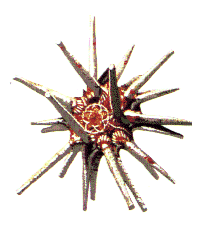 Echinoderms contain several classes known to be venomous. Certain sea urchins have venom organs (globiferous pedicellariae) with calcareous jaws capable of penetrating human tissue, but injuries from these are rare. Sea urchin spines inflict more injuries and can break off in the skin and cause local tissue reactions. If not removed they may migrate into deeper tissues, causing a granulomatous nodular leision, or they may wedge against bone or nerve. Joint and muscle pains and dermatitis may also occur.
Echinoderms contain several classes known to be venomous. Certain sea urchins have venom organs (globiferous pedicellariae) with calcareous jaws capable of penetrating human tissue, but injuries from these are rare. Sea urchin spines inflict more injuries and can break off in the skin and cause local tissue reactions. If not removed they may migrate into deeper tissues, causing a granulomatous nodular leision, or they may wedge against bone or nerve. Joint and muscle pains and dermatitis may also occur.
Treatment for Echinoderm Injuries
Pedicellariae stings are treated by washing the area and applying an antihistamine-analgesic-corticosteroid balm.
Sea urchin spines should be removed immediately. A bluish discoloration at the site of entry may assist in locating the spine. Vinegar dissolves most superficial spines, and soaking the wound in vinegar several times a day and voering the area with a wet vinegar compress my be sufficient. Surgery is seldom necessary. If a small incision needs to be made to extract the spine, care must be taken as it is very fragile. In time, a spine may migrate into deeper tissue and may require surgical removal.

